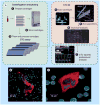Fluid biopsy for solid tumors: a patient's companion for lifelong characterization of their disease
- PMID: 22894671
- PMCID: PMC3658625
- DOI: 10.2217/fon.12.91
Fluid biopsy for solid tumors: a patient's companion for lifelong characterization of their disease
Abstract
Cancer is currently diagnosed and treated based on the results of a tissue biopsy of the primary tumor or a metastasis using invasive techniques such as surgical resection or needle biopsy. New technology for retrieving cancer cells from the circulation, developed in the last 5 years, has made it possible to obtain a 'fluid biopsy' from the bloodstream without the need for an invasive procedure. This technological development makes it possible to diagnose and manage cancer from a blood test rather than from a traditional biopsy. It also allows the repeated sampling of cancer cells from a patient, making it possible, in a practical manner, to interrogate the disease repeatedly in order to understand the mechanisms by which cancer cells evolve within a given individual. The ability to obtain cancer cells repeatedly also has the potential to substantially advance drug development by enabling early ex vivo validation of both targets and early-stage compounds, as well as creating new efficiencies in the drug development process during clinical trials.
Conflict of interest statement
The authors have no other relevant affiliations or financial involvement with any organization or entity with a financial interest in or financial conflict with the subject matter or materials discussed in the manuscript apart from those disclosed.
No writing assistance was utilized in the production of this manuscript.
Figures




References
-
- Cancer Facts & Figures 2011. American Cancer Society; GA, USA: 2011.
-
- Hardy D, Chan W, Liu CC, et al. Racial disparities in length of stay in hospice care by tumor stage in a large elderly cohort with non-small cell lung cancer. Palliat Med. 2012;26(1):61–71. - PubMed
-
- Doroshow JH. Targeting EGFR in non-small-cell lung cancer. N Engl J Med. 2005;353(2):200–202. - PubMed
-
- Kobayashi S, Boggon TJ, Dayaram T, et al. EGFR mutation and resistance of non-small-cell lung cancer to gefitinib. N Engl J Med. 2005;352(8):786–792. - PubMed
Publication types
MeSH terms
Grants and funding
LinkOut - more resources
Full Text Sources
Other Literature Sources
